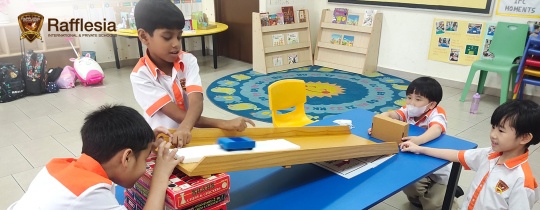Our online Science Fair (19th - 23rd July 2021) was a hugely immersive event – for our young scientists and for the awestruck students who were engrossed in the processes and outcomes of the experiments.
During the preparations and the presentations, our Year 5 students deepened their understanding of the correct procedures for formulating methods and hypotheses, conducting experiments and making conclusion.
Click the links below to watch the full videos. You will be amazed by their awesome experiments!
Experimenter: Aidan Chan Fei Suan
Brief description of project:
To make a small tornado in a bottle of water.
Hypothesis:
- I predict that I can make a tornado in a bottle of water.
- I predict that shaking the bottle harder will make a bigger tornado.
Conclusion:
My prediction was correct. The harder you shake the bigger the tornado and it also lasts longer.
How this is possible? It is because of "centripetal force", which is an inward-facing force that pulls an object or liquid toward the centre of its circular path. The twister created in my bottle is caused by the water in the bottle spinning towards the centre of the bottle, or vortex.
Title of project 2: Dancing Paper
Experimenter: Deevveyeash
Brief description of project:
To determine what are the effects of a rubbed balloon compared to a balloon which is not rubbed affect the movement of the paper.
Hypothesis:
- If the balloon which is not rubbed with the woollen cloth is hovered over the paper, the paper will not move.
- If the rubbed balloon with the woollen cloth is hovered over the paper, the paper will be attracted to the balloon.
Conclusion:
My results support my hypothesis strongly. This is seen as the paper was attracted to the rubbed balloon when it was held over it. The paper flew up and stuck to the balloon.
This happened because the balloon developed a static charge due to the transfer of electrons from one object to another.
Title of project 3: Ice on Rubberband
Experimenter: Turneem
Brief description of project:
To determine if a rubber band can stick on ice if salt is added.
Hypothesis:
- My prediction is that the rubber band can stick to the ice if salt is added.
Conclusion:
The experiment worked. When salt comes into contact with ice, it causes the ice to melt a little bit. The small amount of water from the melted ice and the salt combine together, lowering the freezing point of water (saltwater has a lower freezing point than fresh water by about 4℉). This lowered freezing point makes it harder for water molecules to recrystallise into ice, as a result the ice stick to the string when it is pulled out of the glass.







